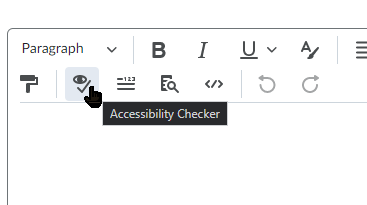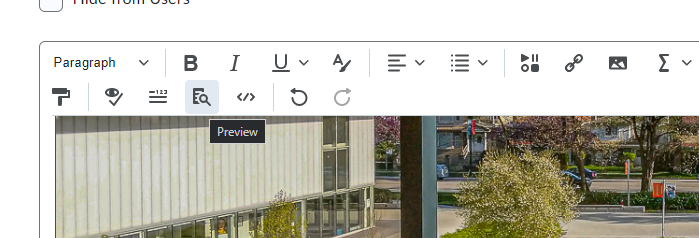Brightspace Accessibility
Accessibility Checker
 The accessibility checker may catch common accessibility issues in your content and offer suggestions to help you fix the issues. The accessibility checker is available on the HTML editor toolbar in Brightspace.
The accessibility checker may catch common accessibility issues in your content and offer suggestions to help you fix the issues. The accessibility checker is available on the HTML editor toolbar in Brightspace.
To use the accessibility checker:
- Open your Brightspace page and select Edit HTML.
- Click the three dots More Actions button if you do not see a second row on the editor toolbar.
- Open the Accessibility Checker.
- Follow the checker prompts to make changes.
- There may be options or additional information depending on type of issue.
Consider this video demonstration:
Accessibility Review
Consider the following manual and automated checks to maximize the accessibility of your Brightspace content:
| Accessibility Consideration | Best Practices |
|---|---|
| Prefer HTML, Word documents, and PowerPoint files. Use accessibility checkers in Brightspace, Word, and PowerPoint. Avoid PDFs as they are exceedingly difficult and time-consuming to make accessible. |
|
| Use font size 16 minimum and prefer sans-serif fonts. | Use the provided templates. |
| Use headings. | Add headings using the Styles menu. Apply headings in sequential order without skipping a heading level. |
| Use numbered lists for steps in a process and bulleted lists for groupings of items. | Use the List menu in the Brightspace editor. |
| Provide meaningful text descriptions of links destinations. Do not include bare URLs or unclear link text such as “click here” or “read more.” |
|
| Ensure adequate colour contrast and do not use colour alone to differentiate or emphasize. |
|
| Provide alternative text. |
|
| Tables are only used to represent data. |
|
| Math content must be accessible. | Use EquatIO or the Brightspace Equation Editor to create accessible math and notation. |
| Caption videos and transcribe audio. |
|
| Any external learning tools and activities are accessible. | Look for accessibility information on the platform or vendor’s webpage. Prepare an alternative activity or assessment in the event of an inaccessibility. |
Checker Results
The accessibility checker tool checks for a number of issues. Below is a summary of what is checked and how well the Brightspace checker does in flagging issues:
| Element checked | Reliability of checker |
|---|---|
| Structure and use of heading styles | Good. Recognizes text that has been formatted to appear as a header but is not tagged as such. Flags headings out of sequential order. Recognizes lists created manually using symbols and suggests creating a semantic list. |
| Colour | Good. Can recognize contrast errors and offers easy methods to improve contrast. Cannot determine if colour is used as sole indication of importance. |
| Use of images | Moderate. Marks images that have neither Alt text, nor are marked as decorative. Flags images where the Alt text is just the file name. Cannot identify whether the Alt text is appropriate or even meaningful. |
| Links | Poor. Does not check for link text. Notes adjacent links directed to the same URL. |
| Plain English | Poor. No readability statistics, only word, character, and paragraph counts. |
| Tables | Good. Notes lack of table caption. Asks for table summary on complex tables. Requires header cell(s). Does not flag merged or split cells as these are accessible in HTML. |
| Miscellaneous | Moderate. Does not check text justification. Does not check embedded media for captions. |
Read more about the Brightspace Accessibility Checker.
Preview Tool
Select the Preview tool on the second row of the editor toolbar to view how the page will appear to students. Use this as a last step to ensure that on top of being accessible, your page appears as you want.

Automated tools built-in to many platforms that check for common accessibility issues. Are not to be considered a guarantee of accessibility.

